deployment of the PLA Navy ships in the - Information Resource ...
deployment of the PLA Navy ships in the - Information Resource ...
deployment of the PLA Navy ships in the - Information Resource ...
Create successful ePaper yourself
Turn your PDF publications into a flip-book with our unique Google optimized e-Paper software.
FFFFFFFFFFFFFFFFFFF<br />
Indian Historical Overview. With <strong>the</strong><br />
successful conduct <strong>of</strong> Shakti tests <strong>in</strong> 1974 and<br />
Pokharan tests <strong>in</strong> 1998 Indian nuclear weaponisation<br />
program started by Dr Homi Bhabha <strong>in</strong> 1965 reached<br />
f<strong>in</strong>al fruition. It prompted none o<strong>the</strong>r than <strong>the</strong> Prime<br />
M<strong>in</strong>ister to proclaim "India is now a Nuclear weapon<br />
state", a motto which has acquired <strong>in</strong>ternational<br />
acceptance. In <strong>the</strong> recent years development <strong>of</strong> Indian<br />
missile programme with Prithvi, Sagarika, Dhanush<br />
and Agni has added credibility to India's nuclear<br />
weapons delivery capability.<br />
Aim<br />
The aim <strong>of</strong> this paper is to exam<strong>in</strong>e assured<br />
Second Strike capability alongwith analysis <strong>of</strong><br />
vulnerability <strong>of</strong> <strong>the</strong> three Vectors viz. I and, Air and Sea<br />
India's Nuclear Doctr<strong>in</strong>e<br />
India's Nuclear doctr<strong>in</strong>e was put forth by <strong>the</strong><br />
National Security Advisory Board (NSAB) <strong>in</strong> 1999 and<br />
subsequently <strong>in</strong> <strong>the</strong> CCS statement issued on 04 Jan<br />
03. It conceptualises that Indian nuclear weapons<br />
would be political <strong>in</strong>struments for enforc<strong>in</strong>g<br />
deterrence ra<strong>the</strong>r than military weapons. The salient<br />
<strong>in</strong>gredients <strong>of</strong> <strong>the</strong> doctr<strong>in</strong>e are highlighted below.<br />
• The doctr<strong>in</strong>e envisages <strong>the</strong> build up <strong>of</strong> a<br />
"credible m<strong>in</strong>imum deterrence", based on a<br />
triad <strong>of</strong> endur<strong>in</strong>g, diverse, flexible and<br />
responsive nuclear delivery means.<br />
• No First Use. The deterrence factor is<br />
fur<strong>the</strong>r emphasised by <strong>the</strong> clause <strong>of</strong> No First Use<br />
(NFU) <strong>of</strong> nuclear weapons aga<strong>in</strong>st Nuclear<br />
Weapon States. It fur<strong>the</strong>r states that nuclear<br />
weapons will not be used aga<strong>in</strong>st States that do<br />
not possess nuclear weapons or are not aligned<br />
with nuclear weapon powers. However, India<br />
has reta<strong>in</strong>ed <strong>the</strong> option <strong>of</strong> use <strong>of</strong> nuclear<br />
weapons aga<strong>in</strong>st non-nuclear weapon states<br />
resort<strong>in</strong>g to use <strong>of</strong> Biological or Chemical<br />
weapons. The declared Indian stand <strong>of</strong> No First<br />
Use is debatable and beyond <strong>the</strong> purview <strong>of</strong> this<br />
paper.<br />
• Massive Retaliation. The doctr<strong>in</strong>e also<br />
espouses massive retaliation designed to <strong>in</strong>flict<br />
unacceptable damage <strong>in</strong> case <strong>of</strong> a First Strike on<br />
Indian territory or Indian forces anywhere. From<br />
this declared stance one could <strong>in</strong>fer that an<br />
FFFFFFFFF<br />
SEPTEMBER 2010<br />
adversary's First Strike would be a massive<br />
multiple serial nuclear attack (greater than what<br />
<strong>the</strong> enemy may have o<strong>the</strong>rwise factored <strong>in</strong>to its<br />
calculations) to <strong>of</strong>fset an effective Second Strike<br />
by India.<br />
First Strike<br />
Technically 'First strike' is an attack so powerful<br />
so as to leave one's adversary with <strong>in</strong>sufficient forces<br />
to <strong>in</strong>flict substantial damage on <strong>the</strong> attacker. S<strong>in</strong>ce <strong>the</strong><br />
Cold War USA, NATO and USSR built large number <strong>of</strong><br />
nuclear weapons, delivery platforms and associated<br />
C3I <strong>in</strong>frastructure with <strong>the</strong> primary task <strong>of</strong> First Strike.<br />
This was required to undertake pre-emptive/ surprise<br />
First Strikes to sufficiently reduce if not completely<br />
elim<strong>in</strong>ate <strong>the</strong> enemy's "Second Strike' capability.<br />
The USA subscribes to Launch on Warn<strong>in</strong>g<br />
(LOW) and Launch under Attack (LUA) postures. This<br />
was done as <strong>the</strong> country believes that unless it was<br />
able to undertake a pre-emptive/ surprise strike, it<br />
stood little chance <strong>of</strong> destroy<strong>in</strong>g all Soviet targets as<br />
required by its war plans. Similarly, NATO and Russia<br />
also believe <strong>in</strong> reta<strong>in</strong><strong>in</strong>g <strong>the</strong> <strong>in</strong>itiative and hence<br />
undertak<strong>in</strong>g First Strike if required. Pakistan does not<br />
have a stated nuclear doctr<strong>in</strong>e, but based on<br />
statements and articles written by authoritative<br />
Pakistan dignitaries, Pakistan reta<strong>in</strong>s <strong>the</strong> option <strong>of</strong> First<br />
Strike aga<strong>in</strong>st overwhelm<strong>in</strong>g conventional force.<br />
Ch<strong>in</strong>a on <strong>the</strong> o<strong>the</strong>r hand has adopted a 'No First Use'<br />
policy but crucially this does not apply to conflicts over<br />
territories claimed by Ch<strong>in</strong>a and hence rema<strong>in</strong>s a<br />
potent threat to countries not only <strong>in</strong> <strong>the</strong> subcont<strong>in</strong>ent<br />
but also <strong>in</strong> South Ch<strong>in</strong>a Sea.<br />
Second Strike<br />
O<strong>the</strong>r than India and Ch<strong>in</strong>a (with <strong>the</strong> caveat <strong>of</strong><br />
territorial conflicts), no o<strong>the</strong>r nation has a declared No<br />
First Use doctr<strong>in</strong>e. India's stand on No First Use is <strong>the</strong><br />
bedrock for establish<strong>in</strong>g a credible Second Strike<br />
capability. This capability could be rightly def<strong>in</strong>ed as<br />
second <strong>in</strong> order <strong>of</strong> utilisation but not <strong>in</strong>ferior <strong>in</strong><br />
capability to first strike. In fact <strong>the</strong> ability <strong>of</strong> establish<strong>in</strong>g<br />
a credible Second Strike capability is more challeng<strong>in</strong>g<br />
than a First Strike. In a First Strike <strong>the</strong> <strong>in</strong>itiative is with<br />
<strong>the</strong> attacker giv<strong>in</strong>g him <strong>the</strong> freedom to choose <strong>the</strong><br />
time, place and quantum <strong>of</strong> attack. Whereas Second<br />
Strike is retaliatory and would require careful plann<strong>in</strong>g<br />
and <strong>in</strong>novation to achieve <strong>the</strong> desired punitive results.<br />
FFFFFFFFF 34


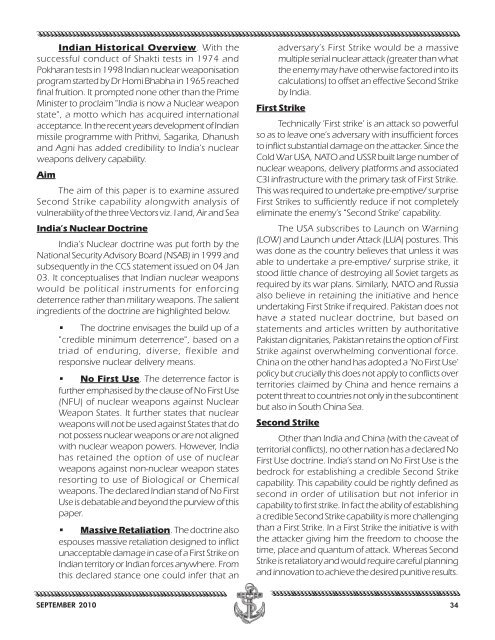

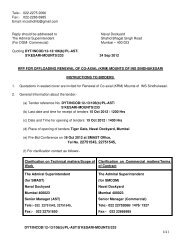
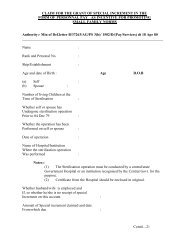
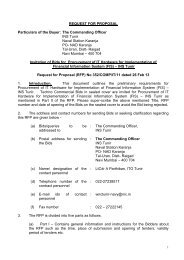
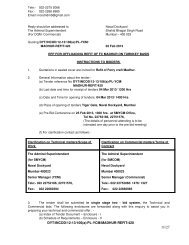
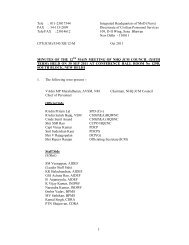

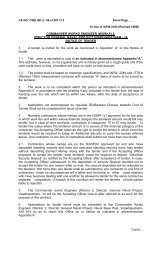
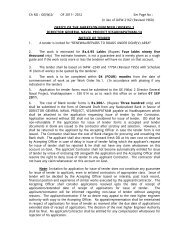
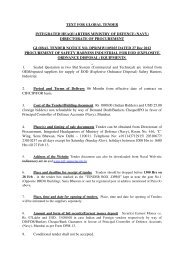
![DGNP[V] - Irfc-nausena.nic.in](https://img.yumpu.com/23509938/1/158x260/dgnpv-irfc-nausenanicin.jpg?quality=85)



